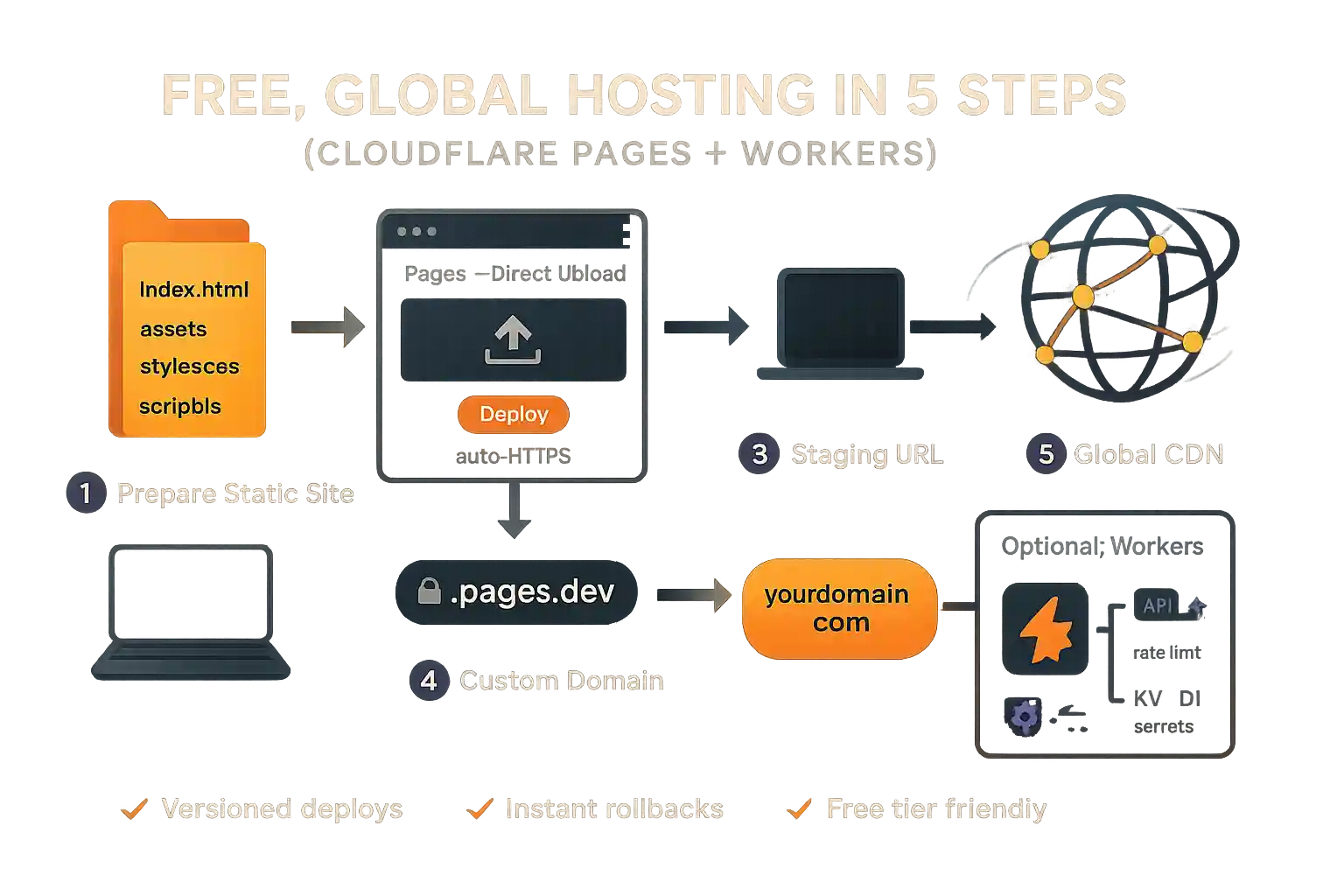How to Host Your Website for Free with Cloudflare: Pages + Workers (2025 Guide)
From paying for servers to “free and global”
Here’s the part most newcomers miss: you don’t need a traditional host to get a fast, globally available site online. Cloudflare’s platform pairs Pages (for static files) with Workers (for optional serverless logic). That combination covers everything from a simple portfolio to a tiny app with API routes—no VPS, no Nginx, no patching.
The fastest path uses a direct, code-free deploy: drag-and-drop your built site into Pages and you instantly get a production URL with HTTPS on a world-scale CDN. When (or if) you need dynamic behavior—contact forms, authenticated endpoints, rate-limited API calls—you can add Workers alongside your static site.
Deploy in 60 seconds: the direct upload flow
- Prepare a folder containing
index.html, CSS, JS, and assets. - In Cloudflare dashboard, go to Workers & Pages → Create application → Pages → Use direct upload.
- Name your project (this also becomes your staging URL).
- Drag your folder (or a .zip) into the uploader and click Deploy.
That’s it. Cloudflare provisions TLS automatically and serves your site at
<project>.pages.dev from its global edge. You can share the link immediately, test on mobile, and iterate without touching a server.
Connect a custom domain (optional but recommended)
When you’re ready to look polished, attach a custom domain. If your DNS already sits on Cloudflare, it’s nearly point-and-click inside the Pages project. If it doesn’t, you’ll add a CNAME pointing to your Pages subdomain. Cloudflare issues the certificate and routes traffic for you—no Let’s Encrypt wrangling.
Prefer visitors to always use your domain rather than .pages.dev? Add a managed redirect so the staging URL 301s to your branded host.
Edit, redeploy, and roll back with confidence
Change a hero image, tweak CSS, add a new page—then create a new deployment. Pages gives you atomic deploys, preview links for each version, and instant rollbacks. Outgrowing manual uploads? Flip to the Git-connected flow so every push builds and deploys automatically.
Add a backend with Workers (only if you need it)
Many sites are fine as pure static, but if you need runtime logic—form handling, data fetch with API key protection, rate limiting-drop in Workers. You can colocate a Worker in front of your Pages site to process requests, set headers, or serve JSON endpoints. Because Workers run at the edge, latency stays low worldwide.
- Examples: contact form that writes to a KV/D1 store, newsletter signup that calls a third-party API with a secret, tiny JSON API for your frontend.
- Tip: cache aggressively at the edge for GET routes and use short TTLs on dynamic pages.
Free-plan guardrails (what to know up front)
The free tier for Pages is generous for personal sites and prototypes. Direct uploads don’t “build” anything, and Git-connected projects have ample monthly build allowance. Workers on the free tier cover a healthy number of requests per day; when you outgrow that, paid plans scale linearly and are inexpensive compared with traditional hosting.
Practical takeaway: if you’re launching a portfolio, marketing page, docs site, or a small app with light serverless needs, you likely won’t hit ceilings early.
Two pro tips so you don’t get surprised
- Pages Functions require a build. If you want server-side code inside a Pages project (Pages Functions), deploy via the CLI (Wrangler) so the function code is compiled and bundled. Direct Upload is ideal for static files only.
- Workers run before the cache. Requests that go through a Worker count as Worker invocations even when content is cached. Design with caching in mind for cost and speed.
The five-step free path, recap
- Prepare your static site folder.
- Deploy via Pages → Direct Upload.
- Share the
.pages.devURL (HTTPS by default). - Attach your custom domain and add a 301 from staging.
- Iterate with new deployments; add Workers only when needed.
Why this stack feels “unfairly good” for indies
You skip the old triangle of “buy hosting, configure a server, tune performance.” Instead you inherit a global CDN, automatic TLS, versioned deploys, and a clean path to add programmable logic later. For many personal sites, prototypes, and early-stage products, that’s the difference between shipping today and never getting around to it.
